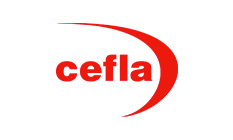
FOCUS ON
Designing and building Data Centers:
everything you need to know.
by Daniele Spada
Data centers host servers, storage units, uninterruptible power supplies and all the equipment that controls the processes and communications of every company IT system. In a nutshell, we could say that any IT system relies on a data center.
Data centers process vast amounts of information, conveying data flows between servers. Data centers host data storage systems, machine/plant monitoring, control and management computer systems and telecommunication systems.
But what’s actually essential for the machines to stay operational?
Air conditioning and environmental control systems. It is, in fact, the advanced cooling, fire fighting and security systems that make data centers safe and operational at all times.
Compliant with certification requirements: ANSI TIA EIA 942
The Telecommunications Industry Association (TIA) is acknowledged by the American National Standard Institute (ANSI) as a developer of industry standards for smart equipment and service networks.
In particular, data center construction guidelines follow the TIA-942 standard which defines the layouts and the design of data centers, as well as their wiring and environmental conditions.
Why is it important to conform to this standard?
Stated simply, to demonstrate the stability and reliability of data center services.
The guidelines established by ANSI/TIA-942 differ according to progressively increasing levels of security (also called TIERS), certifiable by bodies such as the Uptime Institute.
The Tier system provides a snapshot of the data center facility.
The greater the urgency of the core business, the higher the Tier must be to minimise the percentage of risk regarding unavailability.
TIER 1 DATA CENTER
A Tier 1 data center has a single power and cooling circuit. It offers limited protection against physical events, as it is exposed to disruption by both scheduled and unscheduled work. Its backup or redundant components are limited or absent. Given these characteristics, the anticipated downtime may be as high as 28.8 hours/year.
TIER 2 DATA CENTER
A Tier 2 data center has a single power and cooling circuit that includes redundant and backup components. It is better protected against physical events than a Tier 1 data center as it is less likely to be impacted by power outages. Given these characteristics, the guaranteed uptime is 99.7%, with up to 22 hours of downtime per year, also due to shutdowns in the event of maintenance.
TIER 3 DATA CENTER
A Tier 3 data center has a higher number of power and cooling circuits, and several update and maintenance systems that allow its uninterrupted use. It therefore consists of multiple independent distribution pathways. Each one of its components can be removed or overhauled without disrupting the user’s ICT capabilities, as redirection to other power connections is possible. It is characterised by near-total protection against physical events. Additionally, its total downtime may not exceed 1.6 hours/year.
TIER 4 DATA CENTER
A Tier 4 data center is designed to be fault-tolerant. It features redundancy components and multiple independent distribution pathways, allowing maintenance and an extra simultaneous failure to occur without generating any shutdowns. Moreover, it guarantees near-total operability, its uptime figure being 99.995%. Scheduled maintenance is therefore possible, without impacting functionality. Lastly, it is protected against almost all physical events.
Data center energy consumption: the first step towards efficiency.
A medium-sized data center can consume as many kilowatts as 1,000 apartments. In Italy there are about 3,000 data centers: their overall consumption is close to 1 Gigawatt.
Data center consumption is mostly attributable to cooling systems, which play a vital role in dissipating the heat produced by the servers and maintaining a constant temperature inside the facilities.
Understandably, data center consumption has a significant impact on the environment, also due to harmful emissions. For these reasons, their maintenance needs to be improved.
To achieve this, upgrading power continuity technology is a top priority.
There is currently a growing demand for uninterruptible power supplies with batteries of lower environmental impact that let users track any changes during the equipment life cycle. In this respect, lithium-ion batteries have assumed a critically important role for data center artificial powering purposes. Additionally, it is important to identify and anticipate the expected hotspots in a data center. The increased power could cause cooling system failures and server shutdowns.
Hotspots can be located by installing heat-sensitive panels or probes to read air temperature. In fact, data centers are unanimously considered the main releasers of greenhouse gases.
Cefla has been committed to fighting climate change and reducing environmental impact for years One example is the project carried out for UNIPOL, in which Cefla Engineering replaced the existing IT facilities with a new, highly efficient and reliable centralised Tier 4 data center.
The measure of efficiency according to the amount of electricity used is called Power Usage Effectiveness (PUE). The PUE is the ratio of the total power absorbed by the data center to the power used only by the IT equipment. The lower this value, the greater the efficiency of the Data Center.
Another possible cause of energy waste (low efficiency) is poorly managed wiring, which can produce more heat; this, in turn, does not allow the cooling system to function correctly, leading to increased costs and downtime.
INSIGHT
The Cooling System:
why to implement it, and how
Data Centers can use liquid or air cooling systems, or both.
Liquid cooling offers greater, more effective heat dispersion than air systems. For this reason it offers the most suitable response to increased data center power.
In the past, air cooling systems were the most common solution as they were cheaper. However, air has low conductivity and struggles to cope with increased heat output, forcing organisations to increase the size and strength of their fans. Additionally, many companies increase the height of their data centers to facilitate heat dispersion.
Protection:
how to prevent fires
Given their importance, data centers are subject to strict efficiency requisites. A fire could cause a company to suffer serious damage or even force it to close.
Data center fires may also be the result of arson, corporate sabotage or natural causes such as lightning, power surges, or electrical discharges. This is another reason why access to data centers is limited and heavily controlled.
In 1896 the National Fire Protection Association (NFPA) was founded to issue and regulate standards for fire-fighting, fire prevention and fire detection. Data centers are equipped with systems to detect, prevent and extinguish fires.
It is essential to contact this organisation before making any changes to a data center’s fire protection system.
Preventing, detecting and extinguishing fires (possibly caused by faults in electrical circuits, in under-floor systems, UPSs and in other hidden areas) are essential factors in the design and construction of the data center itself.
System: ensuring functionality
A data processing center plays a crucial data/information conveying role. Protecting it with solutions that ensure proper cooling and security against arson, other fires and cyber attacks is therefore essential.
The telecommunications industry association sets the standards required to obtain certification, and the consequent reliability and effectiveness.
To ensure a data center operates smoothly it is good practice to attain high-level protection (preferably Tier 3 or above)
Certification of this type will guarantee its full functionality in relation to the amount of electricity consumed.


